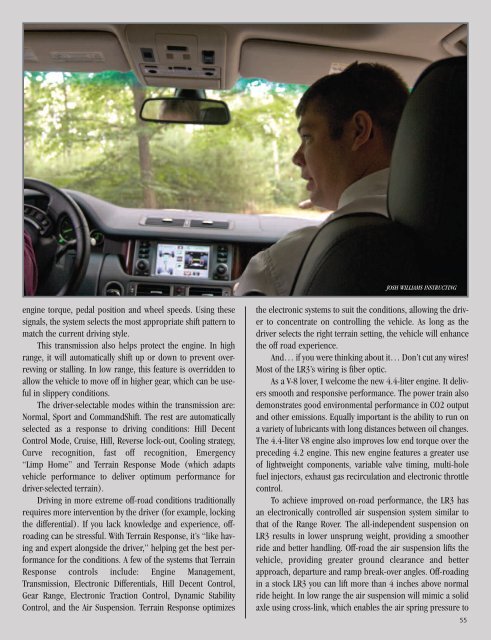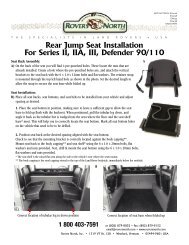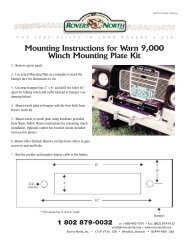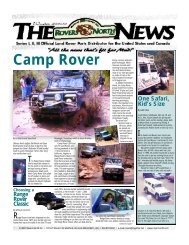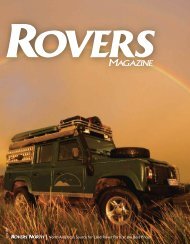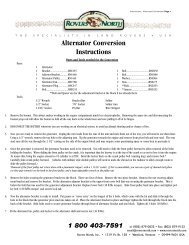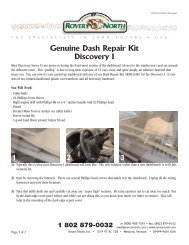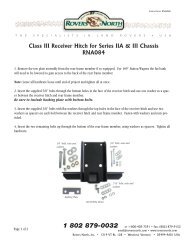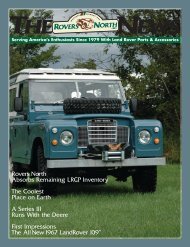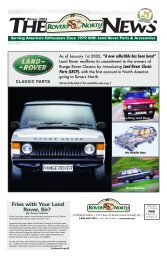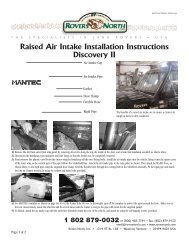Create successful ePaper yourself
Turn your PDF publications into a flip-book with our unique Google optimized e-Paper software.
JOSH WILLIAMS INSTRUCTING<br />
engine torque, pedal position and wheel speeds. Using these<br />
signals, the system selects the most appropriate shift pattern to<br />
match the current driving style.<br />
This transmission also helps protect the engine. In high<br />
range, it will automatically shift up or down to prevent overrevving<br />
or stalling. In low range, this feature is overridden to<br />
allow the vehicle to move off in higher gear, which can be useful<br />
in slippery conditions.<br />
<strong>The</strong> driver-selectable modes within the transmission are:<br />
Normal, Sport and CommandShift. <strong>The</strong> rest are automatically<br />
selected as a response to driving conditions: Hill Decent<br />
Control Mode, Cruise, Hill, Reverse lock-out, Cooling strategy,<br />
Curve recognition, fast off recognition, Emergency<br />
“Limp Home” and Terrain Response Mode (which adapts<br />
vehicle performance to deliver optimum performance for<br />
driver-selected terrain).<br />
Driving in more extreme off-road conditions traditionally<br />
requires more intervention by the driver (for example, locking<br />
the differential). If you lack knowledge and experience, offroading<br />
can be stressful. With Terrain Response, it’s “like having<br />
and expert alongside the driver,” helping get the best performance<br />
for the conditions. A few of the systems that Terrain<br />
Response controls include: Engine Management,<br />
Transmission, Electronic Differentials, Hill Decent Control,<br />
Gear Range, Electronic Traction Control, Dynamic Stability<br />
Control, and the Air Suspension. Terrain Response optimizes<br />
the electronic systems to suit the conditions, allowing the driver<br />
to concentrate on controlling the vehicle. As long as the<br />
driver selects the right terrain setting, the vehicle will enhance<br />
the off road experience.<br />
And… if you were thinking about it… Don’t cut any wires!<br />
Most of the LR3’s wiring is fiber optic.<br />
As a V-8 lover, I welcome the new 4.4-liter engine. It delivers<br />
smooth and responsive performance. <strong>The</strong> power train also<br />
demonstrates good environmental performance in CO2 output<br />
and other emissions. Equally important is the ability to run on<br />
a variety of lubricants with long distances between oil changes.<br />
<strong>The</strong> 4.4-liter V8 engine also improves low end torque over the<br />
preceding 4.2 engine. This new engine features a greater use<br />
of lightweight components, variable valve timing, multi-hole<br />
fuel injectors, exhaust gas recirculation and electronic throttle<br />
control.<br />
To achieve improved on-road performance, the LR3 has<br />
an electronically controlled air suspension system similar to<br />
that of the Range Rover. <strong>The</strong> all-independent suspension on<br />
LR3 results in lower unsprung weight, providing a smoother<br />
ride and better handling. Off-road the air suspension lifts the<br />
vehicle, providing greater ground clearance and better<br />
approach, departure and ramp break-over angles. Off-roading<br />
in a stock LR3 you can lift more than 4 inches above normal<br />
ride height. In low range the air suspension will mimic a solid<br />
axle using cross-link, which enables the air spring pressure to<br />
55


